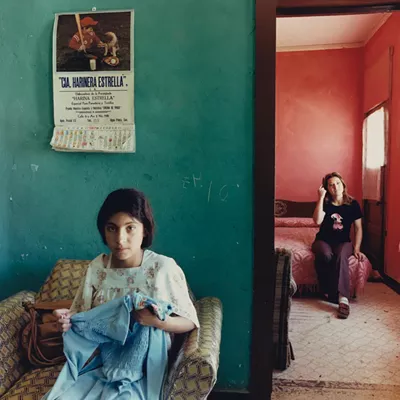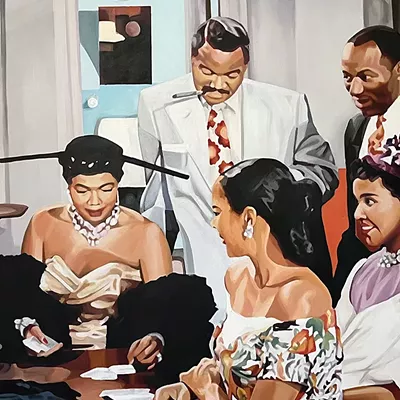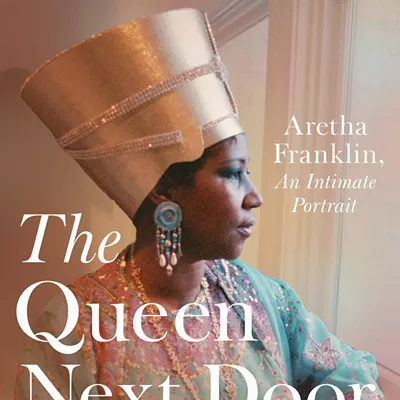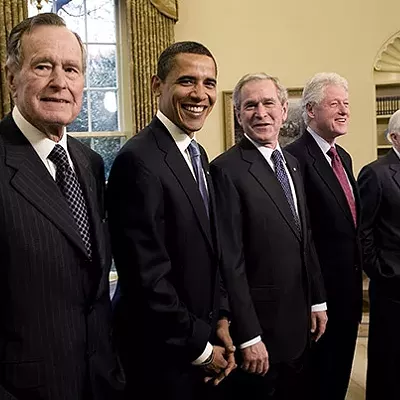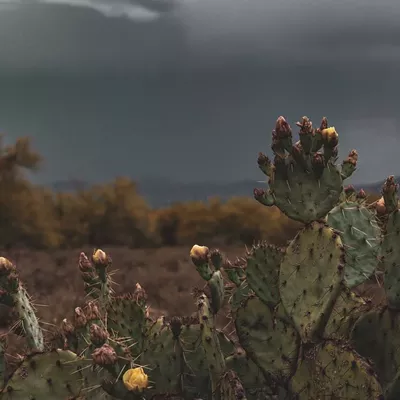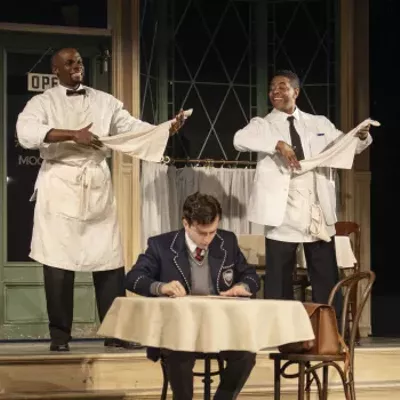Dale Warren, leader of the once-beloved cowboy band, told the Arizona Daily Star's Cathalena Burch that the Sons' departure is a sad sign of the city's changing times.
"That's part of the culture of the whole town," he said. "It seems like the Western element is fading." Not only are the Sons of the Pioneers leaving town; their Western music venue, the Hidden Valley Inn, has closed as well.
The old cow town may be giving way to tony resorts, but Serpa's retirement from the ring has more to do with her advancing age--she's past 80--than the decline of the rodeo. Still, there's something elegiac about her black-and-white photos of cowboys, on view at the Temple Gallery in the show Louise Serpa: Range, Ranch and Rodeo Photographs, in time for this week's still-thriving Tucson Rodeo, La Fiesta de Los Vaqueros.
Quite a few of the 46 prints are 10, 20, 30, even 40 years old, dating back to the days when Serpa broke the gender barrier to become the first female photographer allowed in the ring. (That was in 1965.) Her classic cowboys in classic hats bouncing atop their classic ponies have the look of stopped time. The fresh-faced young rider of "Allen Houston, Scottsdale, Arizona," 1964, testing out a saddle on the ground, glances up at the photog with a big, friendly smile. He's like an archetype from a younger America. You can almost hear him say, "Howdy, ma'am."
"Big Ed, Tucson, Arizona," 1973, is set in the rodeo grounds still in use today, the letters of the painted Tucson Rodeo sign stretching out across the familiar white building. Big Ed is one big horse, and as he leaps out of the chute on his hind legs, he towers maybe 10 feet in the air, dwarfing the cowboys working the gate. An older cowboy in stripes--an official perhaps--is out in the ring unprotected, and he raises one hand in alarm, his body language registering danger. Somehow, this scene, repeated so many thousands of times, over so many years, in real-life rodeos and in Western movies and TV, stands for all cowboys, all horses. It's 1943 and 1973 and 2003 all at once.
Serpa's biography is at least as interesting as her photographs. She grew up East Coast and upper-class, attending the Chapin School and Vassar. Her parents divorced in Nevada when she was still a kid, and the family's required six weeks of residency in the state was her first taste of the Wild West. She spent a summer working a ranch in Wyoming before Vassar, and apparently plotted ever after to get back.
After a divorce of her own, she came back to Nevada armed with a drugstore camera and started photographing the cowboys riding the rodeo circuit. Eventually marrying a wrangler, she ran hunting camps in the mountains and raised sheep in Oregon. She finally landed in Tucson with two daughters and a second set of divorce papers; she needed to earn a living and went pro.
Serpa taught herself photography, apparently learning on the job. At first glance, with all those bucking broncos eternally tossing all those cowboys, her work seems clichéd. But a closer inspection reveals "her instinct for the decisive moment," as a gallery press release has it. She catches cowboys going at lightning speed in all directions, but her photographs are beautifully composed.
In "Hud, Tucson," 1971, the flying cowboy and his mount--make that his dismount--form a pair of C curves arranged in opposition to each other. The rider's arms and legs curve up to the sky, while the horse's two sets of legs curve down to the earth. Their joined backs curl against each other. In "Cotton Eye, Tucson," shot a generation later, 1989, the positions are reversed. This time, the horse is completely in the air, and the cowboy is underneath, cowering into the ground in hopes of not being crushed to death.
"Soldier's Sequence," 1983, is a series of four pictures set up like a stop-motion movie. In the first, the horse is airborne, with the buckaroo clinging sideways to the animal's vertical back. Part two has the horse horizontal in mid-air, and the cowboy still on its back, with one leg flung up to the sky. Next, the horse is still flying, but the cowboy is upside down. Finally, the horse lands on its front legs, its hind legs still in the air. Now it's the cowboy's turn to be completely horizontal; he's in the air, grasping onto the animal with one hand.
No wonder, with these careful studies of motion, shot in dangerous circumstances, that no less an authority than The New Yorker praised Serpa as the successor to Eadweard Muybridge. Muybridge was the 19th-century photographer whose serial photos revealed the fine points of animal locomotion for the first time. Serpa, The New Yorker noted, "extended what Eadweard Muybridge did with horses in the 1870s and with the human form in the 1880s; in her own way, Serpa has revolutionized thinking about bodies in motion."
The later photos are quieter. Serpa has made what amount to still lifes of cowboys' gear, their boots and spurs and chaps. (These pictures were taken pre-Brokeback Mountain, but the sexy close-ups of tight jeans do give pause.) Still shooting in her old age outside the rodeo ring, Serpa is a photographic anthropologist of this all-male world--no female barrel racers charge the field in her pictures.
She's also occasionally turned her eye on the Western landscape. "Imminence, Montana," 1993, is a classic Western long view of big sky, distant mountains and land below. "Sopori Ranch," 2004, is a close-in view of the domesticated land. A rough log fence angles down a slope; the ranchhouse is just beyond, and a pair of mesquites dominate the sky with their feathery leaves.
But Serpa loves the landscape best when it's inhabited by men who wrangle for living, or bang around atop angry bulls. "Davis Ranch, Cimarron, New Mexico," 2002, is a little beauty. A circle of cowboys in their standard-issue black and white hats gather around a calf for a branding. The steam rising up from the animal's seared flesh testifies to the occasional cruelty of their work, but the men in the picture are nonetheless heroic.
In an iPod world, when the Old West is being supplanted by the New West, and the Sons of the Pioneers fade into the sunset, Serpa's cowboys are keeping up tradition, working the land and, in the words of one Arizona writer, "doing what the day brought."

